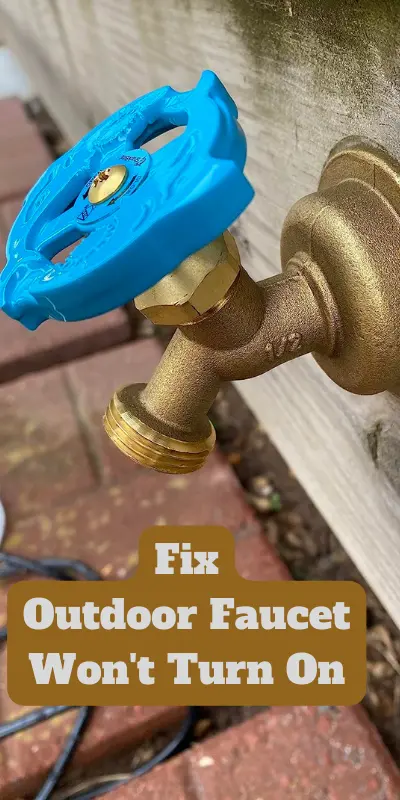You turn on the outdoor faucet to wash your car or water plants in the garden but the outdoor faucet is not turning on, it is jammed. Nothing is more annoying than an outdoor faucet won’t turn on when you have free time to clean your car or water plants. In this situation, no water comes out from the outdoor faucet.
There are a few common reasons that prevent the outside faucet from turning on. With mentioned solutions, in this guide, you can fix the outside faucet alone without experience. Whether you’re a homeowner or a gardening enthusiast, understanding the causes and solutions for a non-functional outdoor faucet can save you time, money, and unnecessary headaches.
How To Fix Outdoor Faucet Won’t Turn On?

Clean Mineral Buildup
When the quantity of naturally present minerals is high, the mineral buildup occurs on different parts of the faucet. When water flows through the faucet, these minerals are deposited on the internal parts of the faucet, including the handle.
When mineral buildup accumulated around the faucet handle, it prevents the handle from properly functioning. These buildups create layers of sediment or scale, causing the handle to become difficult to turn.
The handle may feel stiff, sticky, or resistant to movement, making it inconvenient and frustrating to operate the faucet. In severe cases, the handle may become completely immobile, rendering the faucet unusable.
Vinegar is a safe cleaning solution to remove mineral buildup from the faucet without damaging the outdoor faucet finish and parts. For this, soak the outdoor faucet handle into the vinegar solution.
Mix equal parts of vinegar and water in a bowl or container. Remove the handle and soak it in the solution for a few hours or overnight. The mild acidity of vinegar helps dissolve mineral deposits, making them easier to remove.
Read also – Why Outdoor Faucet Won’t Turn Off?
Fix or Replace Corroded Parts
When the metal part of the faucet interacts with air, water, it causes corrosion. Corrosion is a natural process. According to the quality of the faucet, corrosion will occur. If your outdoor faucet quality is good, corrosion won’t occur for a long time or the whole life of the faucet.
When corrosion occurs in a faucet handle, it can significantly affect its movement and make it harder to turn. The corrosion may form on the handle’s internal parts, such as the spindle or stem, or even the external surface.
With time, it can cause the metal to become rough, pitted, or even seize up, resulting in resistance or stiffness when trying to turn the handle. In severe cases, the handle may become completely immovable.
- Clear away any dirt, leaves, or other debris around the faucet. Use a brush or a cloth to wipe away loose particles.
- You can try vinegar, baking soda, or any safe chemical removal to clean the corrosion. Let sit one of them for 15-20 minutes to allow to dissolve the corrosion.
- Afterward, scrub the area with a brush or toothbrush and rinse with water.
- Once the corrosion is removed, you can polish the faucet with a metal polish or chrome cleaner to restore its shine.
Fix Loose or Damaged Handle
For the smooth movement of the outside faucet handle, it should be tightened properly. A loose or damaged handle won’t be able to move freely. The handle might feel wobbly, making it difficult to grip and turn smoothly.
First, you should try to tighten the screw of the handle. For this use a screwdriver to tighten the screws or bolts holding the handle in place. This can help restore stability and improve the turning motion.
If the faucet is old, tightening won’t help. In this situation, you need to replace the handle. Use a screwdriver or Allen wrench to remove the screw and detach the handle from the stem. Get a new handle for the hardware store and attach it.
Sometimes, a loose or stiff faucet handle can be due to insufficient lubrication. Apply a silicone-based lubricant or plumber’s grease to the handle mechanism, including the stem and any moving parts. This can help reduce friction and improve the handle’s ease of turning. Be cautious not to over-lubricate, as excessive grease can attract dirt and cause more problems.
Read also – Why Outdoor Faucet Leaks When Turned on?
FAQs

How Do I Find The Shut-off Valve on My Outside Faucet?
Before starting any fixing process for the outdoor faucet, you should turn off its water supply. For this, you need to turn off it shut-off valve. The shut-off valve location can vary.
You may find it near the faucet or the ceiling on the inside of the wall where the faucet is located. Maybe there is no shut-off valve for your outdoor faucet, in this situation, turn the main water supply of the house.
Final Thoughts
Having an outdoor faucet that won’t turn on can be a frustrating problem, but it is one that can be resolved with the right troubleshooting steps. In this article, we discussed the possible reasons behind an outdoor faucet not turning on, including water supply issues and faucet-related problems. If you’re unsure or the problem persists, don’t hesitate to consult a professional plumber for assistance.

James Lewis is a seasoned plumber and faucet enthusiast who shares his expertise on Faucetsavvy.com. With over 15 years of experience in the plumbing industry, he’s passionate about helping homeowners find the perfect faucet for their needs. He’s also dedicated to empowering DIY enthusiasts with the plumbing knowledge and skills needed to repair and maintain their faucets.
Recommended By Faucetsavvy's Team
Best Kitchen Faucets of 2025: Sleek, Durable & Worth Every Penny Check Our Review

